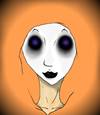The Necronomicon appears quite often in scary stories. But is it real? Does it exist?
Imagine you are lost in the old part of the city, walking down a mist-enshrouded alley and you happen across a mysterious, nameless bookshop. The proprietor is a queer old man with pallid, green-hued skin who reluctantly allows you access to the back room where he keeps, under wraps of yellow satin, an ancient book of magic. Its title reads only: Necronomicon.

The Kitab al Azif
The original Necronomicon is a fictitious grimoire originating in the stories of H.P. Lovecraft that became a tradition when picked up by friends and fellow Weird Tales authors who also invented their own dark tomes and manuals of black magic.
Now about the “terrible and forbidden books”– I am forced to say that most of them are purely imaginary. There never was any Abdul Alhazred or Necronomicon , for I invented these names myself. Robert Bloch devised the idea of Ludvig Prinn and his De Vermis Mysteriis , while the Book of Eibon is an invention of Clark Ashton Smith‘s. Robert E. Howard is responsible for Friedrich von Junzt and his Unaussprechlichen Kulten … As for seriously-written books on dark, occult, and supernatural themes– in all truth they don’t amount to much. That is why it’s more fun to invent mythical works.
–From: The Letters of H.P. Lovecraft
Lovecraft’s given history of the secret and terrible text recalls its authorship by one Abd al Hazred (Abdul Alhazred), the “Mad Arab”, originally titled Al Azif (A cryptic reference to those nocturnal insects which presage evil related to the Lord of the Flies). Alhazred spent ten years alone in the Southern deserts of Arabia, and wrote his book in Damascus before being seized by an invisible being and slaughtered in broad daylight. It was translated from Greek into Latin by Olaus Wormius in 1228, and into English by the alchemyst John Dee in the 1500s. It is the source of the familiar quote: “That is not dead which can eternal lie, and with strange aeons even death may die.”
They walk unseen and foul in lonely places where the words have been spoken and the rites howled through at their seasons. The wind gibbers with Their voices, and the earth mutters with Their consciousness. They bend the forest and crush the city, yet may not forest or city behold the hand that smites. Kadath in the cold waste hath known Them, and what man knows Kadath? The ice desert of the South and the sunken isles of the Ocean hold stones whereon Their seal is engraven, but who hath seen the deep frozen city or the sealed tower long garlanded with seaweed and barnacles?
–From: The Dunwich Horror
Other Books Called The Necronomicon
Many books have been published under the name of Necronomicon,
drawing on the dark reputation of Lovecraft’s mythological grimoire.
H.R. Giger’s Necronomicon
One not purporting to be a book of magic, but rather a book of art, is that containing the gruesome adult artwork of H.R. Giger. It recognizably shaped the design of the movie Alien.
The Simon Necronomicon
In the 1980s a new book arrived on store shelves with little or no true information about its history, (in a mass market paperback, no less,) which is today referred to as the ”Simon Necronomicon”. The book has itself developed into a theoretical occult reference. It is, nonetheless, a hoax attempting to appear as a grimoire in the magical traditions of The Lesser Key of Solomon or The Sixth and Seventh Books of Moses.
The authors subsequently published a history if its writing, called Gates of the Necronomicon (1997) that describes its creation by people involved in the scene surrounding the New York City bookstore Magickal Childe in the late 1970s. This was followed by Dead Names: The Dark History of the Necronomicon and The Necronomicon Spell Book .
(The copyright registration for Simon’s Gates of the Necronomicon lists the author as Peter Levenda, who is believed by some to be Simon, though he has publicly denied this claim.)
Derived (loosely) from scholarly translations of Babylonian texts like [archive.org] and the works mentioned in its bibliography, such as R. C. Thompson’s The Devils and Evil Spirits of Babylonia and James B. Pritchard’s Ancient Near Eastern Texts Relating to the Old Testament among others. The Simon Necronomicon includes none of the text quoted in any of Lovecraft’s works.
The George Hay Necronomicon
A similar popular culture rendition is George Hay’s Necronomicon (Necronomicon: The Book of Dead Names). It was originally published in 1978, and in paperback by Corgi Books (1980), and is admittedly a spoof.
In his essay “The Necronomicon— The Origin of a Spoof” (printed in issue #23 of Crypt of Cthulhu magazine, published back in 1984), Colin Wilson, the writer of the introduction to this volume, clearly states that this book was a fraud wrought by himself with the assistance of several of his associates. It is a fascinating article and it details the genesis of this version, and the steps taken to make it seem plausible. Wilson states, “The fact that he [Gerald Suster—a serious student of magic], found it necessary to denounce such an obvious spoof indicates that we succeeded beyond my original expectations.”
SOURCE: Church of Satan: The Necronomicon- Facts About Fiction
The Necronomicon Ex Mortis
The Necronomicon Ex Mortis is an ancient magical tome used in the Evil Dead movies and television series (referred to as The Necronomicon in the original movie). It is used in the same campy, ancient magical grimoire motif as was originally presented by Lovecraft and his compatriots in sci-fi horror.
As for writing the Necronomicon—I wish I had the energy and ingenuity to do it! I fear it would be quite a job in view of the very diverse passages and intimations which I have in the course of time attributed to it! I might, though, issue an abridged Necronomicon—containing such parts as are considered at least reasonably safe for the perusal of mankind! When von Juntz’s Black Book and the poems of Justin Geoffrey are on the market, I shall certainly have to think about the immortalisation of old Abdul!
From: H.P. Lovecraft’s letter to Robert E. Howard (May 7, 1932)




I found more infos. Check this out:
https://fr.scribd.com/doc/173846348/Necronomicon-Arabic-English
https://fr.scribd.com/doc/174402508/Warning-for-the-Necronomicon-Aspiring-Reader
great post! i had no idea about any of this stuff.